ENGG5812: Agile Project Delivery & Approaches: Case Study Report
VerifiedAdded on 2023/06/13
|16
|5577
|468
Report
AI Summary
This assignment provides a detailed exploration of agile project delivery approaches, focusing on servant leadership and the relationship between Lean and Kanban methods. It discusses the characteristics of servant leadership in an agile context, explains the concept of cadence in agile projects, and outlines the connection between Lean and Kanban, highlighting their origins and applications in optimizing business processes. Furthermore, the report identifies key factors to consider when determining the suitability of an agile approach for a project, including uncertainty, complexity, team empowerment, criticality, and urgency. The second part of the assignment presents a project delivery plan for addressing the isolation of a remote community in the Northern Territory after rainfall, detailing the strategic alignment, benefits, scope, deliverables, delivery approach, governance, procurement, development, deployment, human resource management, milestones, stakeholders, and change management strategies.
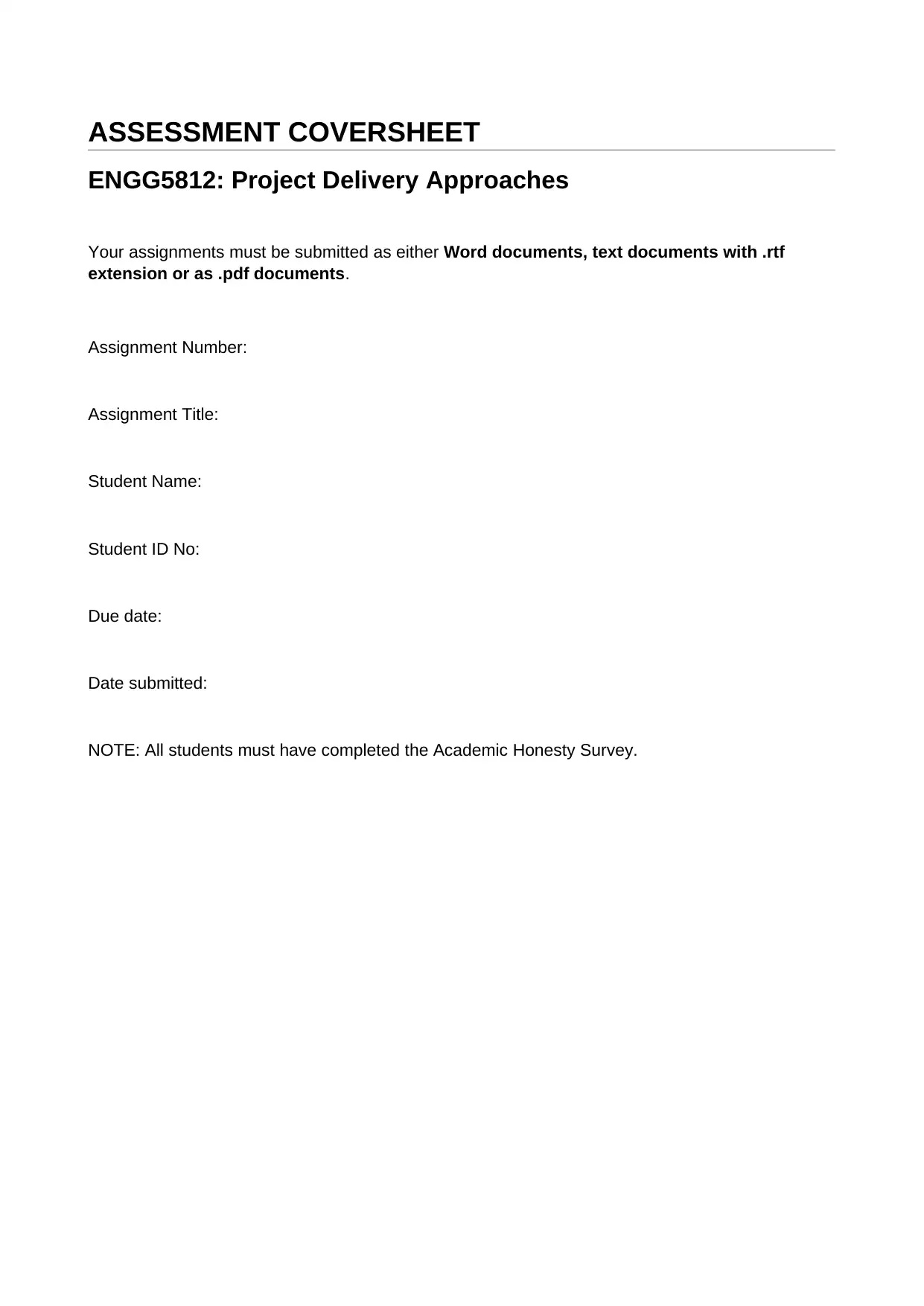
ASSESSMENT COVERSHEET
ENGG5812: Project Delivery Approaches
Your assignments must be submitted as either Word documents, text documents with .rtf
extension or as .pdf documents.
Assignment Number:
Assignment Title:
Student Name:
Student ID No:
Due date:
Date submitted:
NOTE: All students must have completed the Academic Honesty Survey.
ENGG5812: Project Delivery Approaches
Your assignments must be submitted as either Word documents, text documents with .rtf
extension or as .pdf documents.
Assignment Number:
Assignment Title:
Student Name:
Student ID No:
Due date:
Date submitted:
NOTE: All students must have completed the Academic Honesty Survey.
Paraphrase This Document
Need a fresh take? Get an instant paraphrase of this document with our AI Paraphraser
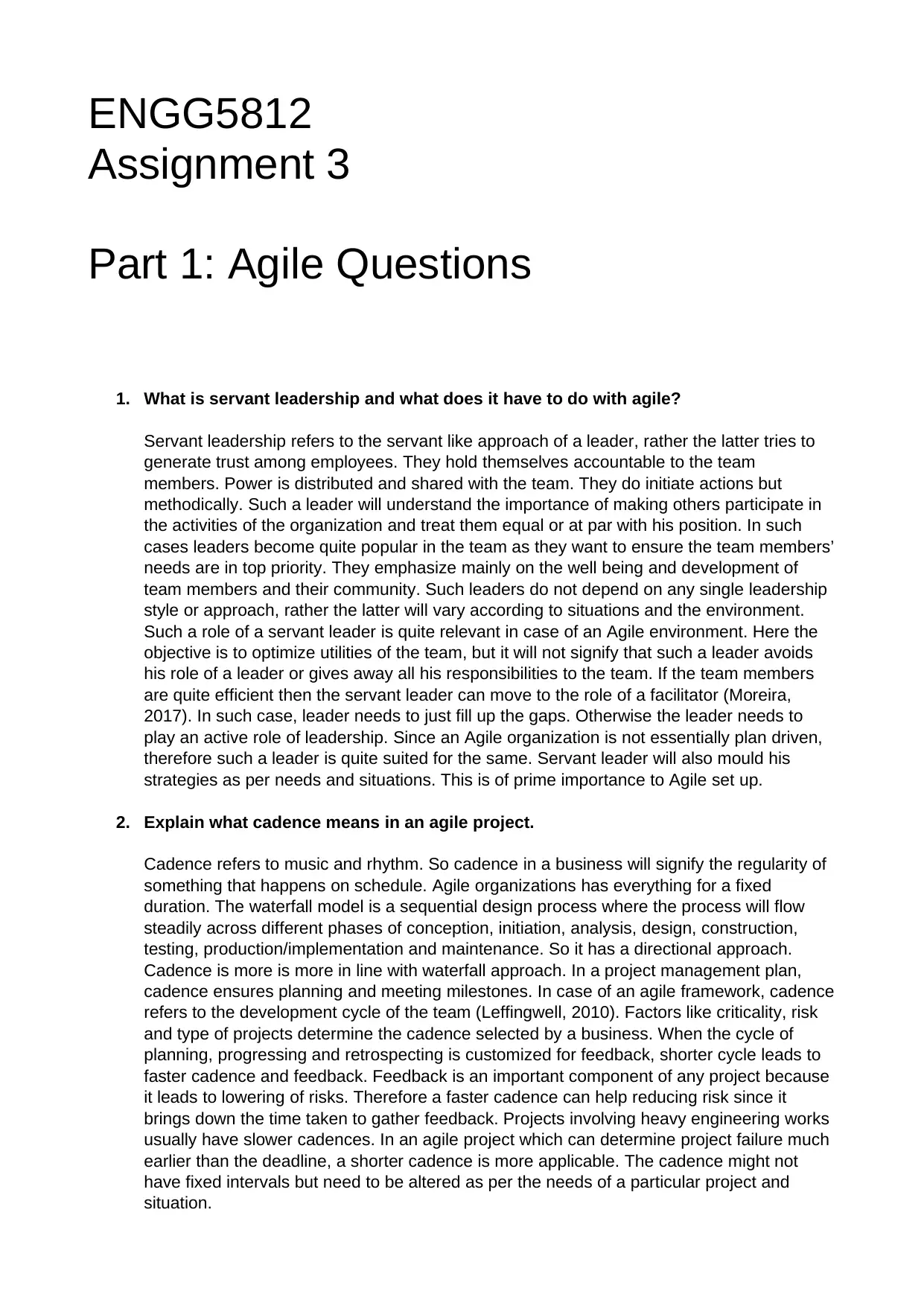
ENGG5812
Assignment 3
Part 1: Agile Questions
1. What is servant leadership and what does it have to do with agile?
Servant leadership refers to the servant like approach of a leader, rather the latter tries to
generate trust among employees. They hold themselves accountable to the team
members. Power is distributed and shared with the team. They do initiate actions but
methodically. Such a leader will understand the importance of making others participate in
the activities of the organization and treat them equal or at par with his position. In such
cases leaders become quite popular in the team as they want to ensure the team members’
needs are in top priority. They emphasize mainly on the well being and development of
team members and their community. Such leaders do not depend on any single leadership
style or approach, rather the latter will vary according to situations and the environment.
Such a role of a servant leader is quite relevant in case of an Agile environment. Here the
objective is to optimize utilities of the team, but it will not signify that such a leader avoids
his role of a leader or gives away all his responsibilities to the team. If the team members
are quite efficient then the servant leader can move to the role of a facilitator (Moreira,
2017). In such case, leader needs to just fill up the gaps. Otherwise the leader needs to
play an active role of leadership. Since an Agile organization is not essentially plan driven,
therefore such a leader is quite suited for the same. Servant leader will also mould his
strategies as per needs and situations. This is of prime importance to Agile set up.
2. Explain what cadence means in an agile project.
Cadence refers to music and rhythm. So cadence in a business will signify the regularity of
something that happens on schedule. Agile organizations has everything for a fixed
duration. The waterfall model is a sequential design process where the process will flow
steadily across different phases of conception, initiation, analysis, design, construction,
testing, production/implementation and maintenance. So it has a directional approach.
Cadence is more is more in line with waterfall approach. In a project management plan,
cadence ensures planning and meeting milestones. In case of an agile framework, cadence
refers to the development cycle of the team (Leffingwell, 2010). Factors like criticality, risk
and type of projects determine the cadence selected by a business. When the cycle of
planning, progressing and retrospecting is customized for feedback, shorter cycle leads to
faster cadence and feedback. Feedback is an important component of any project because
it leads to lowering of risks. Therefore a faster cadence can help reducing risk since it
brings down the time taken to gather feedback. Projects involving heavy engineering works
usually have slower cadences. In an agile project which can determine project failure much
earlier than the deadline, a shorter cadence is more applicable. The cadence might not
have fixed intervals but need to be altered as per the needs of a particular project and
situation.
Assignment 3
Part 1: Agile Questions
1. What is servant leadership and what does it have to do with agile?
Servant leadership refers to the servant like approach of a leader, rather the latter tries to
generate trust among employees. They hold themselves accountable to the team
members. Power is distributed and shared with the team. They do initiate actions but
methodically. Such a leader will understand the importance of making others participate in
the activities of the organization and treat them equal or at par with his position. In such
cases leaders become quite popular in the team as they want to ensure the team members’
needs are in top priority. They emphasize mainly on the well being and development of
team members and their community. Such leaders do not depend on any single leadership
style or approach, rather the latter will vary according to situations and the environment.
Such a role of a servant leader is quite relevant in case of an Agile environment. Here the
objective is to optimize utilities of the team, but it will not signify that such a leader avoids
his role of a leader or gives away all his responsibilities to the team. If the team members
are quite efficient then the servant leader can move to the role of a facilitator (Moreira,
2017). In such case, leader needs to just fill up the gaps. Otherwise the leader needs to
play an active role of leadership. Since an Agile organization is not essentially plan driven,
therefore such a leader is quite suited for the same. Servant leader will also mould his
strategies as per needs and situations. This is of prime importance to Agile set up.
2. Explain what cadence means in an agile project.
Cadence refers to music and rhythm. So cadence in a business will signify the regularity of
something that happens on schedule. Agile organizations has everything for a fixed
duration. The waterfall model is a sequential design process where the process will flow
steadily across different phases of conception, initiation, analysis, design, construction,
testing, production/implementation and maintenance. So it has a directional approach.
Cadence is more is more in line with waterfall approach. In a project management plan,
cadence ensures planning and meeting milestones. In case of an agile framework, cadence
refers to the development cycle of the team (Leffingwell, 2010). Factors like criticality, risk
and type of projects determine the cadence selected by a business. When the cycle of
planning, progressing and retrospecting is customized for feedback, shorter cycle leads to
faster cadence and feedback. Feedback is an important component of any project because
it leads to lowering of risks. Therefore a faster cadence can help reducing risk since it
brings down the time taken to gather feedback. Projects involving heavy engineering works
usually have slower cadences. In an agile project which can determine project failure much
earlier than the deadline, a shorter cadence is more applicable. The cadence might not
have fixed intervals but need to be altered as per the needs of a particular project and
situation.
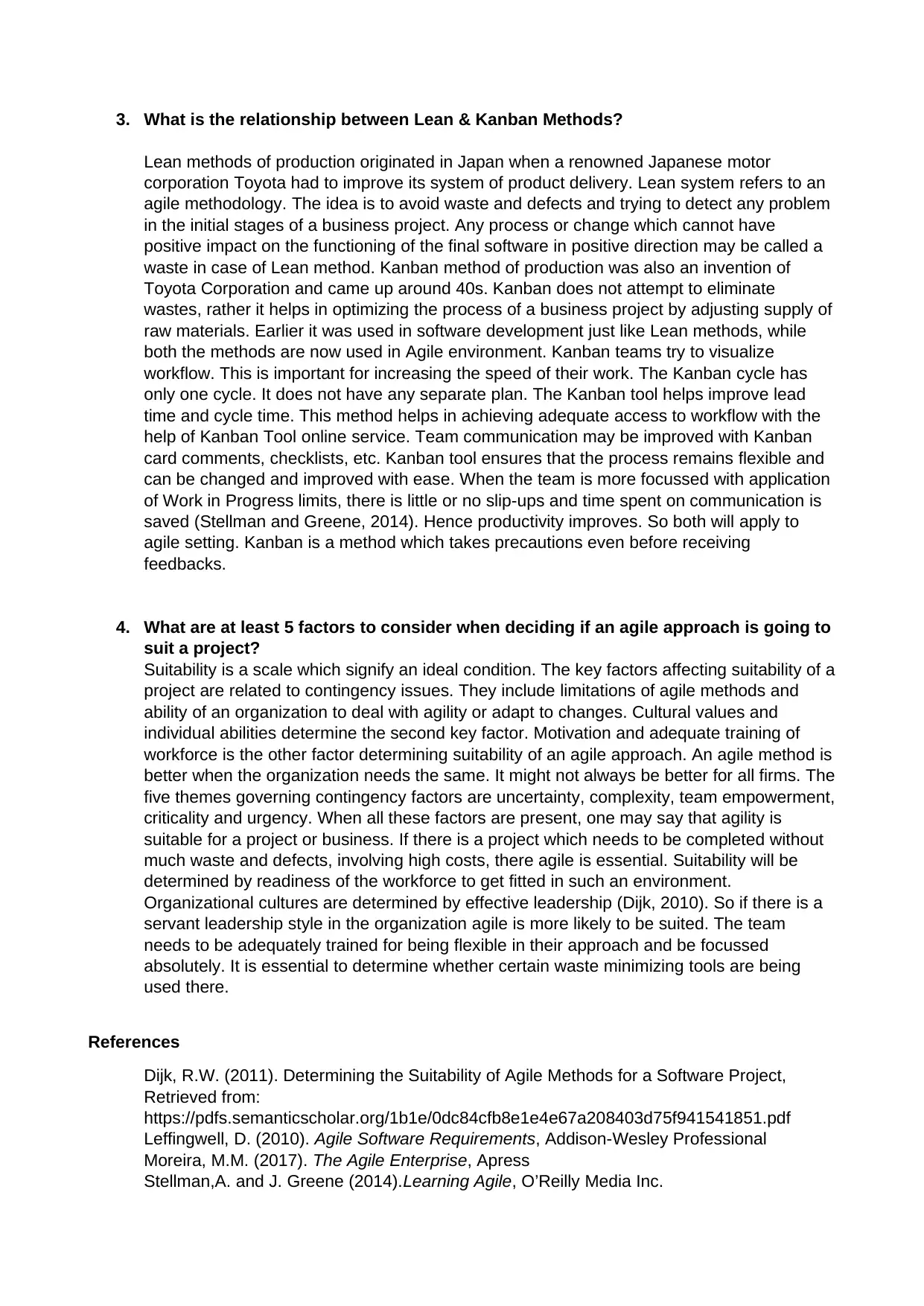
3. What is the relationship between Lean & Kanban Methods?
Lean methods of production originated in Japan when a renowned Japanese motor
corporation Toyota had to improve its system of product delivery. Lean system refers to an
agile methodology. The idea is to avoid waste and defects and trying to detect any problem
in the initial stages of a business project. Any process or change which cannot have
positive impact on the functioning of the final software in positive direction may be called a
waste in case of Lean method. Kanban method of production was also an invention of
Toyota Corporation and came up around 40s. Kanban does not attempt to eliminate
wastes, rather it helps in optimizing the process of a business project by adjusting supply of
raw materials. Earlier it was used in software development just like Lean methods, while
both the methods are now used in Agile environment. Kanban teams try to visualize
workflow. This is important for increasing the speed of their work. The Kanban cycle has
only one cycle. It does not have any separate plan. The Kanban tool helps improve lead
time and cycle time. This method helps in achieving adequate access to workflow with the
help of Kanban Tool online service. Team communication may be improved with Kanban
card comments, checklists, etc. Kanban tool ensures that the process remains flexible and
can be changed and improved with ease. When the team is more focussed with application
of Work in Progress limits, there is little or no slip-ups and time spent on communication is
saved (Stellman and Greene, 2014). Hence productivity improves. So both will apply to
agile setting. Kanban is a method which takes precautions even before receiving
feedbacks.
4. What are at least 5 factors to consider when deciding if an agile approach is going to
suit a project?
Suitability is a scale which signify an ideal condition. The key factors affecting suitability of a
project are related to contingency issues. They include limitations of agile methods and
ability of an organization to deal with agility or adapt to changes. Cultural values and
individual abilities determine the second key factor. Motivation and adequate training of
workforce is the other factor determining suitability of an agile approach. An agile method is
better when the organization needs the same. It might not always be better for all firms. The
five themes governing contingency factors are uncertainty, complexity, team empowerment,
criticality and urgency. When all these factors are present, one may say that agility is
suitable for a project or business. If there is a project which needs to be completed without
much waste and defects, involving high costs, there agile is essential. Suitability will be
determined by readiness of the workforce to get fitted in such an environment.
Organizational cultures are determined by effective leadership (Dijk, 2010). So if there is a
servant leadership style in the organization agile is more likely to be suited. The team
needs to be adequately trained for being flexible in their approach and be focussed
absolutely. It is essential to determine whether certain waste minimizing tools are being
used there.
References
Dijk, R.W. (2011). Determining the Suitability of Agile Methods for a Software Project,
Retrieved from:
https://pdfs.semanticscholar.org/1b1e/0dc84cfb8e1e4e67a208403d75f941541851.pdf
Leffingwell, D. (2010). Agile Software Requirements, Addison-Wesley Professional
Moreira, M.M. (2017). The Agile Enterprise, Apress
Stellman,A. and J. Greene (2014).Learning Agile, O’Reilly Media Inc.
Lean methods of production originated in Japan when a renowned Japanese motor
corporation Toyota had to improve its system of product delivery. Lean system refers to an
agile methodology. The idea is to avoid waste and defects and trying to detect any problem
in the initial stages of a business project. Any process or change which cannot have
positive impact on the functioning of the final software in positive direction may be called a
waste in case of Lean method. Kanban method of production was also an invention of
Toyota Corporation and came up around 40s. Kanban does not attempt to eliminate
wastes, rather it helps in optimizing the process of a business project by adjusting supply of
raw materials. Earlier it was used in software development just like Lean methods, while
both the methods are now used in Agile environment. Kanban teams try to visualize
workflow. This is important for increasing the speed of their work. The Kanban cycle has
only one cycle. It does not have any separate plan. The Kanban tool helps improve lead
time and cycle time. This method helps in achieving adequate access to workflow with the
help of Kanban Tool online service. Team communication may be improved with Kanban
card comments, checklists, etc. Kanban tool ensures that the process remains flexible and
can be changed and improved with ease. When the team is more focussed with application
of Work in Progress limits, there is little or no slip-ups and time spent on communication is
saved (Stellman and Greene, 2014). Hence productivity improves. So both will apply to
agile setting. Kanban is a method which takes precautions even before receiving
feedbacks.
4. What are at least 5 factors to consider when deciding if an agile approach is going to
suit a project?
Suitability is a scale which signify an ideal condition. The key factors affecting suitability of a
project are related to contingency issues. They include limitations of agile methods and
ability of an organization to deal with agility or adapt to changes. Cultural values and
individual abilities determine the second key factor. Motivation and adequate training of
workforce is the other factor determining suitability of an agile approach. An agile method is
better when the organization needs the same. It might not always be better for all firms. The
five themes governing contingency factors are uncertainty, complexity, team empowerment,
criticality and urgency. When all these factors are present, one may say that agility is
suitable for a project or business. If there is a project which needs to be completed without
much waste and defects, involving high costs, there agile is essential. Suitability will be
determined by readiness of the workforce to get fitted in such an environment.
Organizational cultures are determined by effective leadership (Dijk, 2010). So if there is a
servant leadership style in the organization agile is more likely to be suited. The team
needs to be adequately trained for being flexible in their approach and be focussed
absolutely. It is essential to determine whether certain waste minimizing tools are being
used there.
References
Dijk, R.W. (2011). Determining the Suitability of Agile Methods for a Software Project,
Retrieved from:
https://pdfs.semanticscholar.org/1b1e/0dc84cfb8e1e4e67a208403d75f941541851.pdf
Leffingwell, D. (2010). Agile Software Requirements, Addison-Wesley Professional
Moreira, M.M. (2017). The Agile Enterprise, Apress
Stellman,A. and J. Greene (2014).Learning Agile, O’Reilly Media Inc.
⊘ This is a preview!⊘
Do you want full access?
Subscribe today to unlock all pages.

Trusted by 1+ million students worldwide
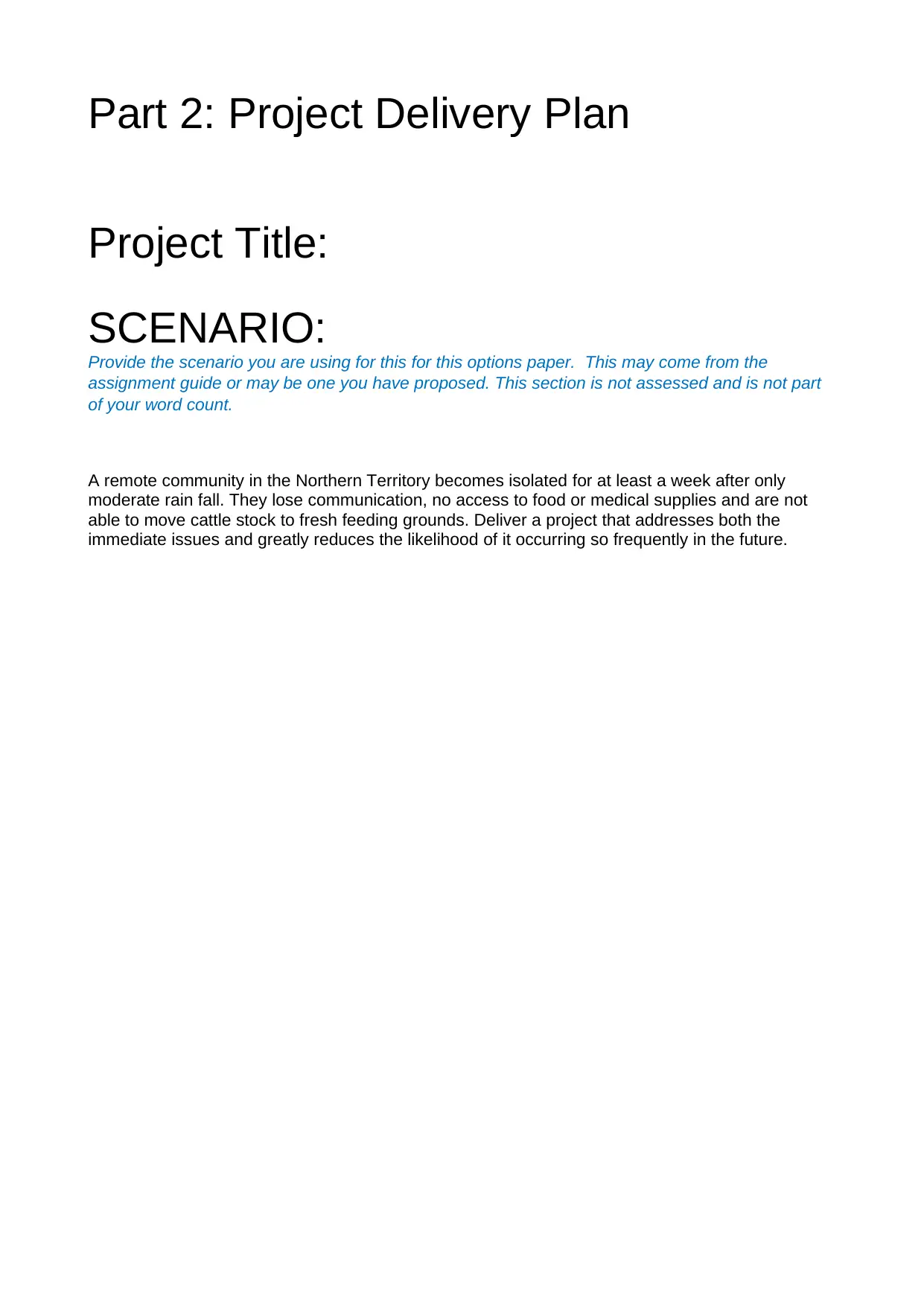
Part 2: Project Delivery Plan
Project Title:
SCENARIO:
Provide the scenario you are using for this for this options paper. This may come from the
assignment guide or may be one you have proposed. This section is not assessed and is not part
of your word count.
A remote community in the Northern Territory becomes isolated for at least a week after only
moderate rain fall. They lose communication, no access to food or medical supplies and are not
able to move cattle stock to fresh feeding grounds. Deliver a project that addresses both the
immediate issues and greatly reduces the likelihood of it occurring so frequently in the future.
Project Title:
SCENARIO:
Provide the scenario you are using for this for this options paper. This may come from the
assignment guide or may be one you have proposed. This section is not assessed and is not part
of your word count.
A remote community in the Northern Territory becomes isolated for at least a week after only
moderate rain fall. They lose communication, no access to food or medical supplies and are not
able to move cattle stock to fresh feeding grounds. Deliver a project that addresses both the
immediate issues and greatly reduces the likelihood of it occurring so frequently in the future.
Paraphrase This Document
Need a fresh take? Get an instant paraphrase of this document with our AI Paraphraser
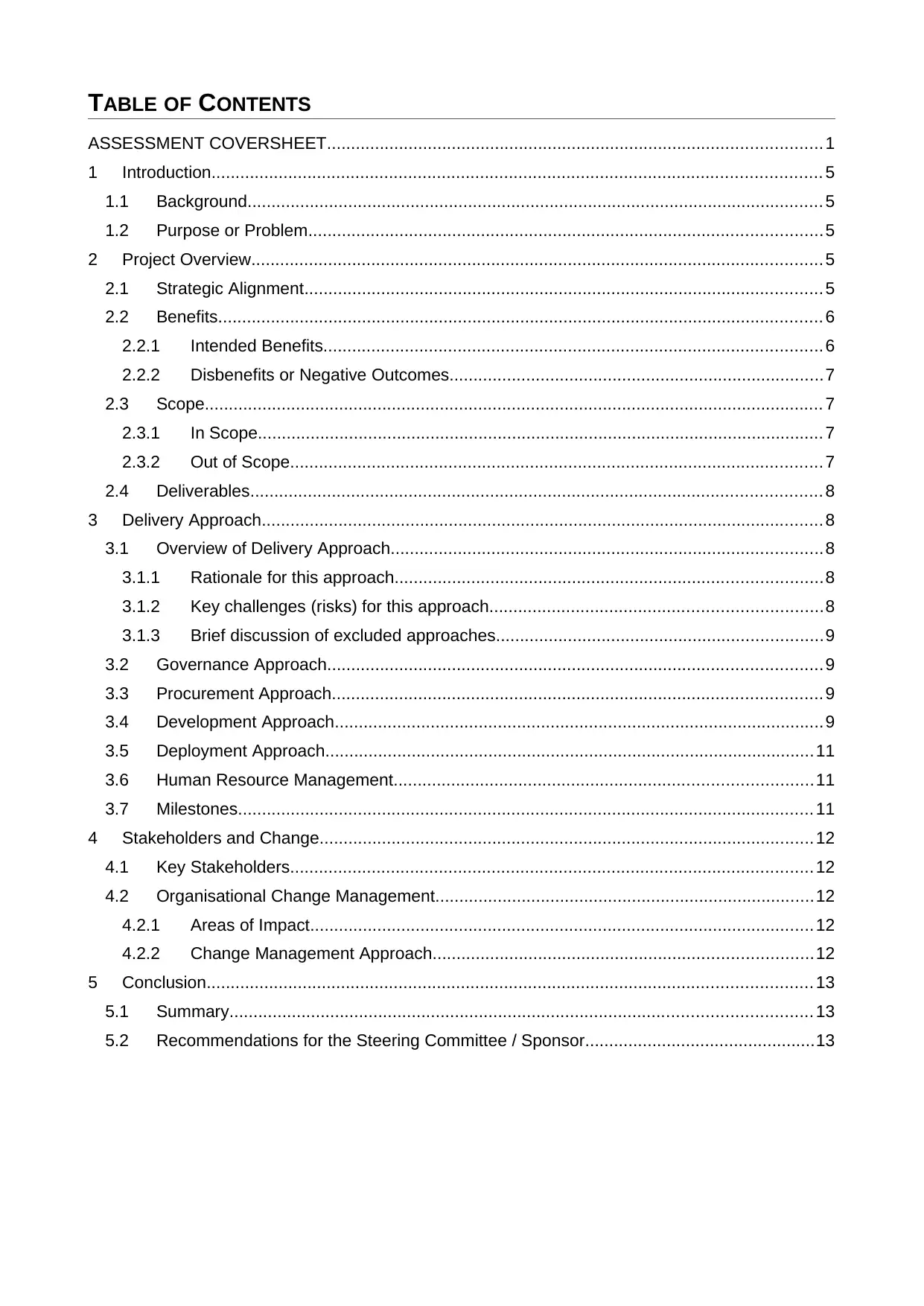
TABLE OF CONTENTS
ASSESSMENT COVERSHEET.......................................................................................................1
1 Introduction............................................................................................................................... 5
1.1 Background........................................................................................................................ 5
1.2 Purpose or Problem...........................................................................................................5
2 Project Overview....................................................................................................................... 5
2.1 Strategic Alignment............................................................................................................ 5
2.2 Benefits.............................................................................................................................. 6
2.2.1 Intended Benefits........................................................................................................6
2.2.2 Disbenefits or Negative Outcomes..............................................................................7
2.3 Scope................................................................................................................................. 7
2.3.1 In Scope...................................................................................................................... 7
2.3.2 Out of Scope............................................................................................................... 7
2.4 Deliverables....................................................................................................................... 8
3 Delivery Approach.....................................................................................................................8
3.1 Overview of Delivery Approach..........................................................................................8
3.1.1 Rationale for this approach.........................................................................................8
3.1.2 Key challenges (risks) for this approach.....................................................................8
3.1.3 Brief discussion of excluded approaches....................................................................9
3.2 Governance Approach.......................................................................................................9
3.3 Procurement Approach......................................................................................................9
3.4 Development Approach......................................................................................................9
3.5 Deployment Approach......................................................................................................11
3.6 Human Resource Management.......................................................................................11
3.7 Milestones........................................................................................................................ 11
4 Stakeholders and Change.......................................................................................................12
4.1 Key Stakeholders............................................................................................................. 12
4.2 Organisational Change Management...............................................................................12
4.2.1 Areas of Impact.........................................................................................................12
4.2.2 Change Management Approach...............................................................................12
5 Conclusion.............................................................................................................................. 13
5.1 Summary......................................................................................................................... 13
5.2 Recommendations for the Steering Committee / Sponsor................................................13
ASSESSMENT COVERSHEET.......................................................................................................1
1 Introduction............................................................................................................................... 5
1.1 Background........................................................................................................................ 5
1.2 Purpose or Problem...........................................................................................................5
2 Project Overview....................................................................................................................... 5
2.1 Strategic Alignment............................................................................................................ 5
2.2 Benefits.............................................................................................................................. 6
2.2.1 Intended Benefits........................................................................................................6
2.2.2 Disbenefits or Negative Outcomes..............................................................................7
2.3 Scope................................................................................................................................. 7
2.3.1 In Scope...................................................................................................................... 7
2.3.2 Out of Scope............................................................................................................... 7
2.4 Deliverables....................................................................................................................... 8
3 Delivery Approach.....................................................................................................................8
3.1 Overview of Delivery Approach..........................................................................................8
3.1.1 Rationale for this approach.........................................................................................8
3.1.2 Key challenges (risks) for this approach.....................................................................8
3.1.3 Brief discussion of excluded approaches....................................................................9
3.2 Governance Approach.......................................................................................................9
3.3 Procurement Approach......................................................................................................9
3.4 Development Approach......................................................................................................9
3.5 Deployment Approach......................................................................................................11
3.6 Human Resource Management.......................................................................................11
3.7 Milestones........................................................................................................................ 11
4 Stakeholders and Change.......................................................................................................12
4.1 Key Stakeholders............................................................................................................. 12
4.2 Organisational Change Management...............................................................................12
4.2.1 Areas of Impact.........................................................................................................12
4.2.2 Change Management Approach...............................................................................12
5 Conclusion.............................................................................................................................. 13
5.1 Summary......................................................................................................................... 13
5.2 Recommendations for the Steering Committee / Sponsor................................................13
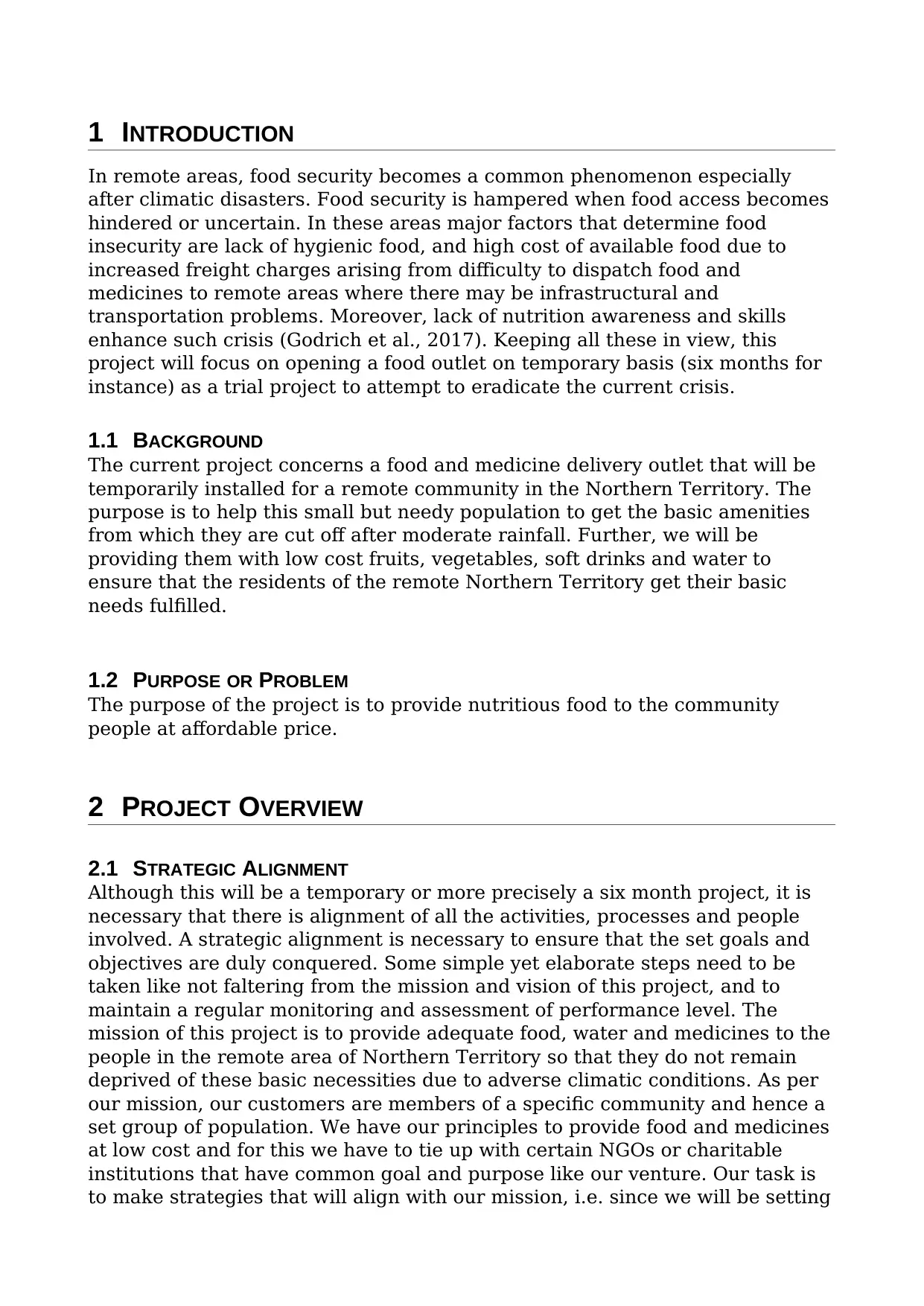
1 INTRODUCTION
In remote areas, food security becomes a common phenomenon especially
after climatic disasters. Food security is hampered when food access becomes
hindered or uncertain. In these areas major factors that determine food
insecurity are lack of hygienic food, and high cost of available food due to
increased freight charges arising from difficulty to dispatch food and
medicines to remote areas where there may be infrastructural and
transportation problems. Moreover, lack of nutrition awareness and skills
enhance such crisis (Godrich et al., 2017). Keeping all these in view, this
project will focus on opening a food outlet on temporary basis (six months for
instance) as a trial project to attempt to eradicate the current crisis.
1.1 BACKGROUND
The current project concerns a food and medicine delivery outlet that will be
temporarily installed for a remote community in the Northern Territory. The
purpose is to help this small but needy population to get the basic amenities
from which they are cut off after moderate rainfall. Further, we will be
providing them with low cost fruits, vegetables, soft drinks and water to
ensure that the residents of the remote Northern Territory get their basic
needs fulfilled.
1.2 PURPOSE OR PROBLEM
The purpose of the project is to provide nutritious food to the community
people at affordable price.
2 PROJECT OVERVIEW
2.1 STRATEGIC ALIGNMENT
Although this will be a temporary or more precisely a six month project, it is
necessary that there is alignment of all the activities, processes and people
involved. A strategic alignment is necessary to ensure that the set goals and
objectives are duly conquered. Some simple yet elaborate steps need to be
taken like not faltering from the mission and vision of this project, and to
maintain a regular monitoring and assessment of performance level. The
mission of this project is to provide adequate food, water and medicines to the
people in the remote area of Northern Territory so that they do not remain
deprived of these basic necessities due to adverse climatic conditions. As per
our mission, our customers are members of a specific community and hence a
set group of population. We have our principles to provide food and medicines
at low cost and for this we have to tie up with certain NGOs or charitable
institutions that have common goal and purpose like our venture. Our task is
to make strategies that will align with our mission, i.e. since we will be setting
In remote areas, food security becomes a common phenomenon especially
after climatic disasters. Food security is hampered when food access becomes
hindered or uncertain. In these areas major factors that determine food
insecurity are lack of hygienic food, and high cost of available food due to
increased freight charges arising from difficulty to dispatch food and
medicines to remote areas where there may be infrastructural and
transportation problems. Moreover, lack of nutrition awareness and skills
enhance such crisis (Godrich et al., 2017). Keeping all these in view, this
project will focus on opening a food outlet on temporary basis (six months for
instance) as a trial project to attempt to eradicate the current crisis.
1.1 BACKGROUND
The current project concerns a food and medicine delivery outlet that will be
temporarily installed for a remote community in the Northern Territory. The
purpose is to help this small but needy population to get the basic amenities
from which they are cut off after moderate rainfall. Further, we will be
providing them with low cost fruits, vegetables, soft drinks and water to
ensure that the residents of the remote Northern Territory get their basic
needs fulfilled.
1.2 PURPOSE OR PROBLEM
The purpose of the project is to provide nutritious food to the community
people at affordable price.
2 PROJECT OVERVIEW
2.1 STRATEGIC ALIGNMENT
Although this will be a temporary or more precisely a six month project, it is
necessary that there is alignment of all the activities, processes and people
involved. A strategic alignment is necessary to ensure that the set goals and
objectives are duly conquered. Some simple yet elaborate steps need to be
taken like not faltering from the mission and vision of this project, and to
maintain a regular monitoring and assessment of performance level. The
mission of this project is to provide adequate food, water and medicines to the
people in the remote area of Northern Territory so that they do not remain
deprived of these basic necessities due to adverse climatic conditions. As per
our mission, our customers are members of a specific community and hence a
set group of population. We have our principles to provide food and medicines
at low cost and for this we have to tie up with certain NGOs or charitable
institutions that have common goal and purpose like our venture. Our task is
to make strategies that will align with our mission, i.e. since we will be setting
⊘ This is a preview!⊘
Do you want full access?
Subscribe today to unlock all pages.

Trusted by 1+ million students worldwide
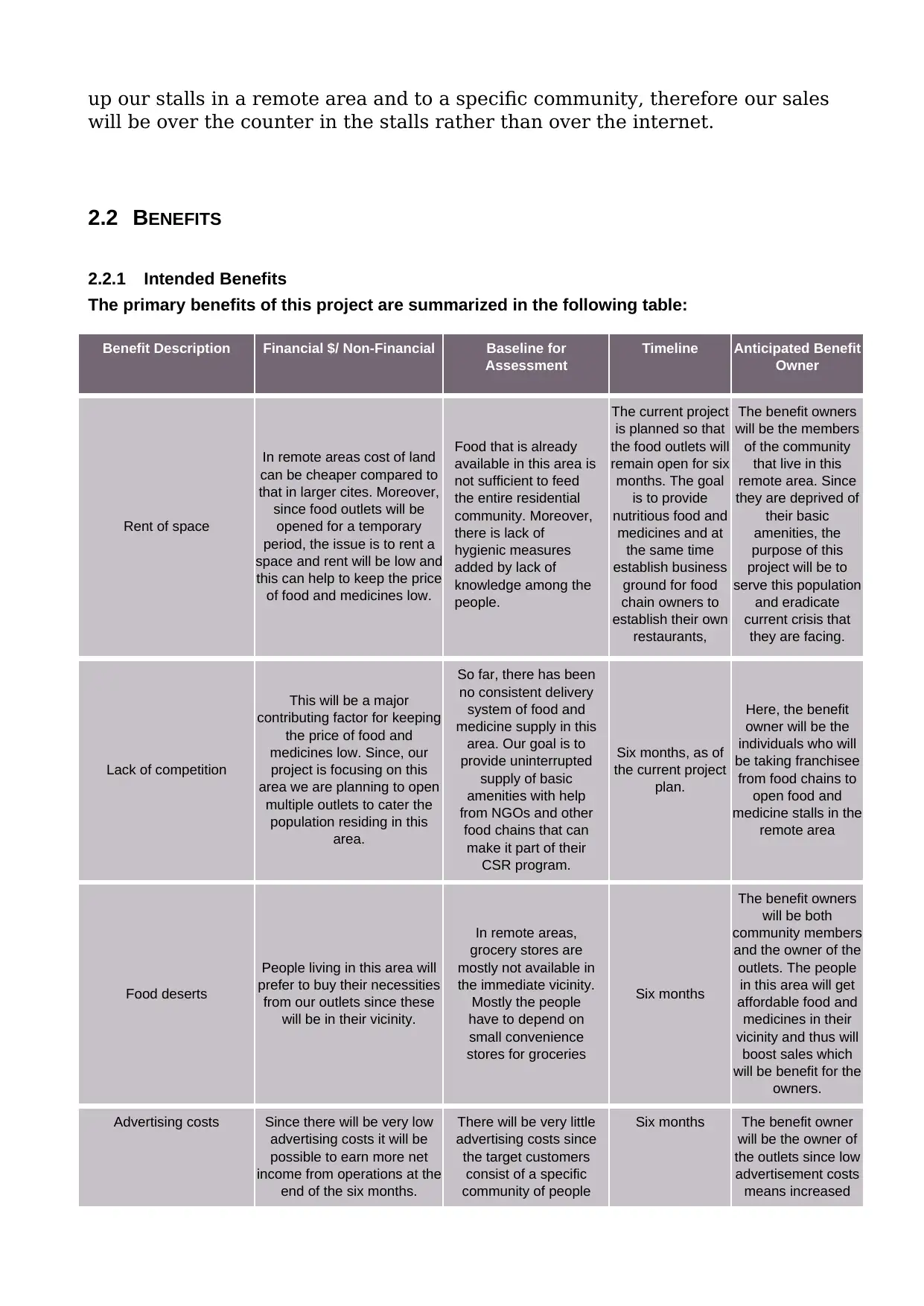
up our stalls in a remote area and to a specific community, therefore our sales
will be over the counter in the stalls rather than over the internet.
2.2 BENEFITS
2.2.1 Intended Benefits
The primary benefits of this project are summarized in the following table:
Benefit Description Financial $/ Non-Financial Baseline for
Assessment
Timeline Anticipated Benefit
Owner
Rent of space
In remote areas cost of land
can be cheaper compared to
that in larger cites. Moreover,
since food outlets will be
opened for a temporary
period, the issue is to rent a
space and rent will be low and
this can help to keep the price
of food and medicines low.
Food that is already
available in this area is
not sufficient to feed
the entire residential
community. Moreover,
there is lack of
hygienic measures
added by lack of
knowledge among the
people.
The current project
is planned so that
the food outlets will
remain open for six
months. The goal
is to provide
nutritious food and
medicines and at
the same time
establish business
ground for food
chain owners to
establish their own
restaurants,
The benefit owners
will be the members
of the community
that live in this
remote area. Since
they are deprived of
their basic
amenities, the
purpose of this
project will be to
serve this population
and eradicate
current crisis that
they are facing.
Lack of competition
This will be a major
contributing factor for keeping
the price of food and
medicines low. Since, our
project is focusing on this
area we are planning to open
multiple outlets to cater the
population residing in this
area.
So far, there has been
no consistent delivery
system of food and
medicine supply in this
area. Our goal is to
provide uninterrupted
supply of basic
amenities with help
from NGOs and other
food chains that can
make it part of their
CSR program.
Six months, as of
the current project
plan.
Here, the benefit
owner will be the
individuals who will
be taking franchisee
from food chains to
open food and
medicine stalls in the
remote area
Food deserts
People living in this area will
prefer to buy their necessities
from our outlets since these
will be in their vicinity.
In remote areas,
grocery stores are
mostly not available in
the immediate vicinity.
Mostly the people
have to depend on
small convenience
stores for groceries
Six months
The benefit owners
will be both
community members
and the owner of the
outlets. The people
in this area will get
affordable food and
medicines in their
vicinity and thus will
boost sales which
will be benefit for the
owners.
Advertising costs Since there will be very low
advertising costs it will be
possible to earn more net
income from operations at the
end of the six months.
There will be very little
advertising costs since
the target customers
consist of a specific
community of people
Six months The benefit owner
will be the owner of
the outlets since low
advertisement costs
means increased
will be over the counter in the stalls rather than over the internet.
2.2 BENEFITS
2.2.1 Intended Benefits
The primary benefits of this project are summarized in the following table:
Benefit Description Financial $/ Non-Financial Baseline for
Assessment
Timeline Anticipated Benefit
Owner
Rent of space
In remote areas cost of land
can be cheaper compared to
that in larger cites. Moreover,
since food outlets will be
opened for a temporary
period, the issue is to rent a
space and rent will be low and
this can help to keep the price
of food and medicines low.
Food that is already
available in this area is
not sufficient to feed
the entire residential
community. Moreover,
there is lack of
hygienic measures
added by lack of
knowledge among the
people.
The current project
is planned so that
the food outlets will
remain open for six
months. The goal
is to provide
nutritious food and
medicines and at
the same time
establish business
ground for food
chain owners to
establish their own
restaurants,
The benefit owners
will be the members
of the community
that live in this
remote area. Since
they are deprived of
their basic
amenities, the
purpose of this
project will be to
serve this population
and eradicate
current crisis that
they are facing.
Lack of competition
This will be a major
contributing factor for keeping
the price of food and
medicines low. Since, our
project is focusing on this
area we are planning to open
multiple outlets to cater the
population residing in this
area.
So far, there has been
no consistent delivery
system of food and
medicine supply in this
area. Our goal is to
provide uninterrupted
supply of basic
amenities with help
from NGOs and other
food chains that can
make it part of their
CSR program.
Six months, as of
the current project
plan.
Here, the benefit
owner will be the
individuals who will
be taking franchisee
from food chains to
open food and
medicine stalls in the
remote area
Food deserts
People living in this area will
prefer to buy their necessities
from our outlets since these
will be in their vicinity.
In remote areas,
grocery stores are
mostly not available in
the immediate vicinity.
Mostly the people
have to depend on
small convenience
stores for groceries
Six months
The benefit owners
will be both
community members
and the owner of the
outlets. The people
in this area will get
affordable food and
medicines in their
vicinity and thus will
boost sales which
will be benefit for the
owners.
Advertising costs Since there will be very low
advertising costs it will be
possible to earn more net
income from operations at the
end of the six months.
There will be very little
advertising costs since
the target customers
consist of a specific
community of people
Six months The benefit owner
will be the owner of
the outlets since low
advertisement costs
means increased
Paraphrase This Document
Need a fresh take? Get an instant paraphrase of this document with our AI Paraphraser
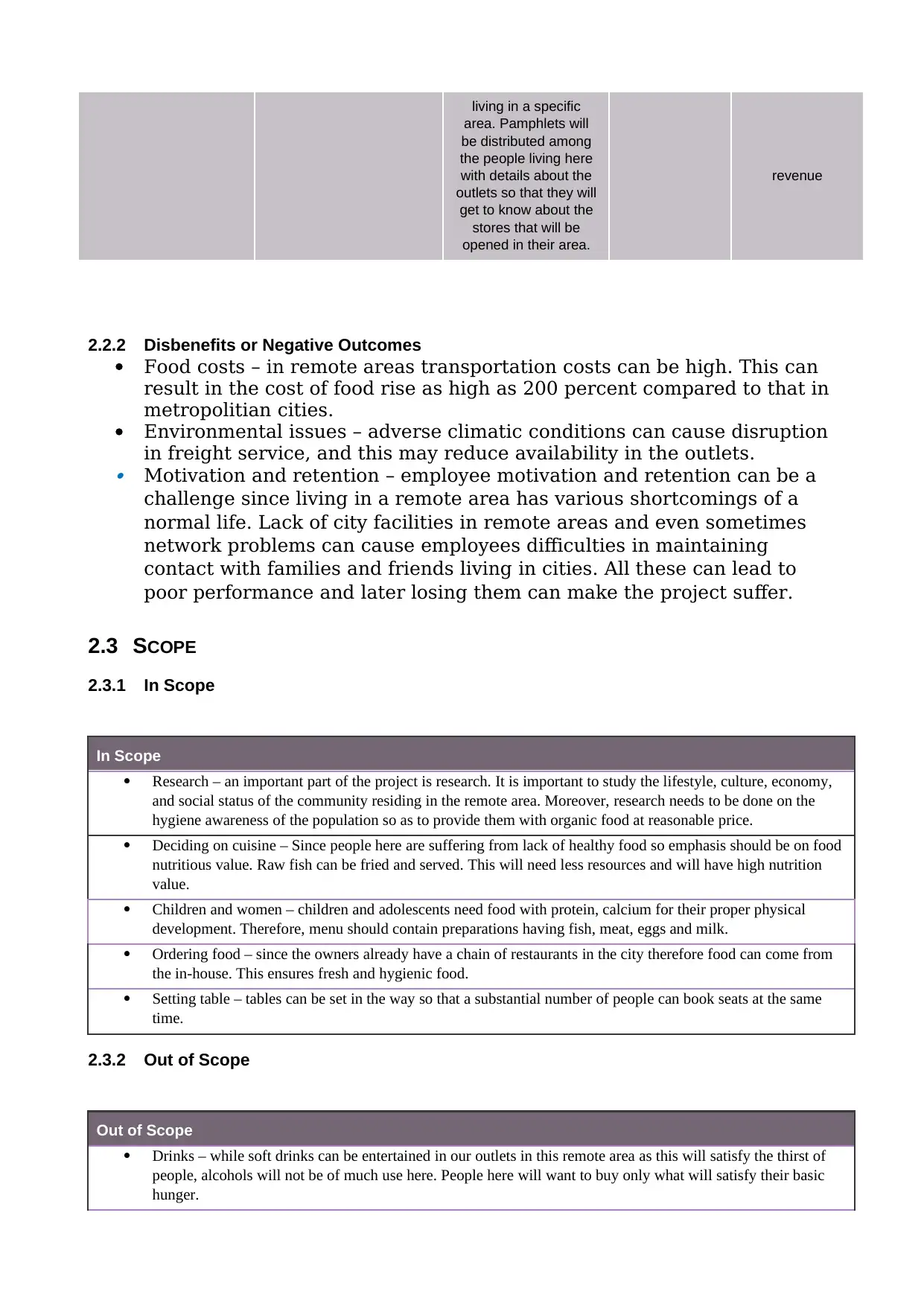
living in a specific
area. Pamphlets will
be distributed among
the people living here
with details about the
outlets so that they will
get to know about the
stores that will be
opened in their area.
revenue
2.2.2 Disbenefits or Negative Outcomes
Food costs – in remote areas transportation costs can be high. This can
result in the cost of food rise as high as 200 percent compared to that in
metropolitian cities.
Environmental issues – adverse climatic conditions can cause disruption
in freight service, and this may reduce availability in the outlets.
Motivation and retention – employee motivation and retention can be a
challenge since living in a remote area has various shortcomings of a
normal life. Lack of city facilities in remote areas and even sometimes
network problems can cause employees difficulties in maintaining
contact with families and friends living in cities. All these can lead to
poor performance and later losing them can make the project suffer.
2.3 SCOPE
2.3.1 In Scope
In Scope
Research – an important part of the project is research. It is important to study the lifestyle, culture, economy,
and social status of the community residing in the remote area. Moreover, research needs to be done on the
hygiene awareness of the population so as to provide them with organic food at reasonable price.
Deciding on cuisine – Since people here are suffering from lack of healthy food so emphasis should be on food
nutritious value. Raw fish can be fried and served. This will need less resources and will have high nutrition
value.
Children and women – children and adolescents need food with protein, calcium for their proper physical
development. Therefore, menu should contain preparations having fish, meat, eggs and milk.
Ordering food – since the owners already have a chain of restaurants in the city therefore food can come from
the in-house. This ensures fresh and hygienic food.
Setting table – tables can be set in the way so that a substantial number of people can book seats at the same
time.
2.3.2 Out of Scope
Out of Scope
Drinks – while soft drinks can be entertained in our outlets in this remote area as this will satisfy the thirst of
people, alcohols will not be of much use here. People here will want to buy only what will satisfy their basic
hunger.
area. Pamphlets will
be distributed among
the people living here
with details about the
outlets so that they will
get to know about the
stores that will be
opened in their area.
revenue
2.2.2 Disbenefits or Negative Outcomes
Food costs – in remote areas transportation costs can be high. This can
result in the cost of food rise as high as 200 percent compared to that in
metropolitian cities.
Environmental issues – adverse climatic conditions can cause disruption
in freight service, and this may reduce availability in the outlets.
Motivation and retention – employee motivation and retention can be a
challenge since living in a remote area has various shortcomings of a
normal life. Lack of city facilities in remote areas and even sometimes
network problems can cause employees difficulties in maintaining
contact with families and friends living in cities. All these can lead to
poor performance and later losing them can make the project suffer.
2.3 SCOPE
2.3.1 In Scope
In Scope
Research – an important part of the project is research. It is important to study the lifestyle, culture, economy,
and social status of the community residing in the remote area. Moreover, research needs to be done on the
hygiene awareness of the population so as to provide them with organic food at reasonable price.
Deciding on cuisine – Since people here are suffering from lack of healthy food so emphasis should be on food
nutritious value. Raw fish can be fried and served. This will need less resources and will have high nutrition
value.
Children and women – children and adolescents need food with protein, calcium for their proper physical
development. Therefore, menu should contain preparations having fish, meat, eggs and milk.
Ordering food – since the owners already have a chain of restaurants in the city therefore food can come from
the in-house. This ensures fresh and hygienic food.
Setting table – tables can be set in the way so that a substantial number of people can book seats at the same
time.
2.3.2 Out of Scope
Out of Scope
Drinks – while soft drinks can be entertained in our outlets in this remote area as this will satisfy the thirst of
people, alcohols will not be of much use here. People here will want to buy only what will satisfy their basic
hunger.
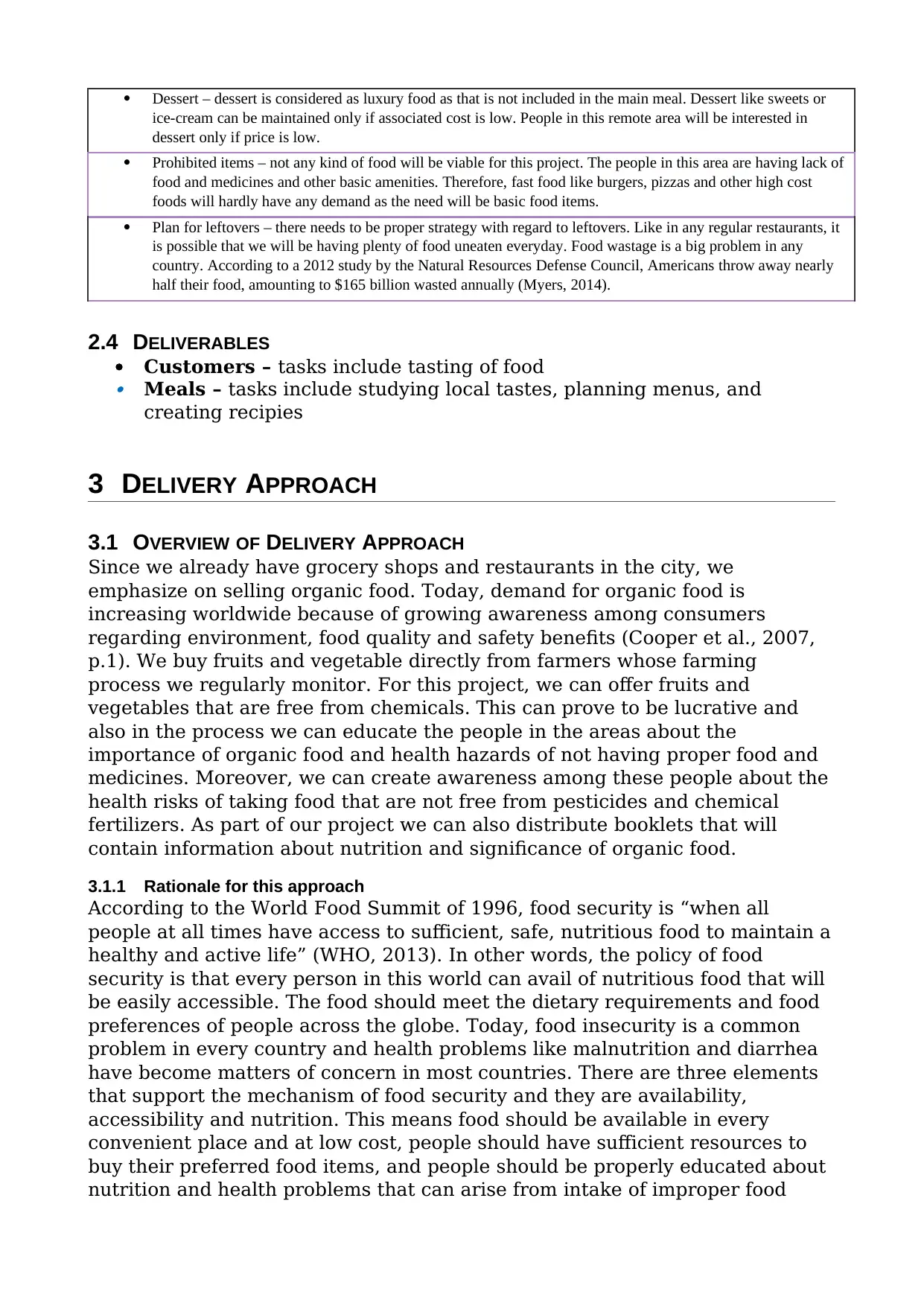
Dessert – dessert is considered as luxury food as that is not included in the main meal. Dessert like sweets or
ice-cream can be maintained only if associated cost is low. People in this remote area will be interested in
dessert only if price is low.
Prohibited items – not any kind of food will be viable for this project. The people in this area are having lack of
food and medicines and other basic amenities. Therefore, fast food like burgers, pizzas and other high cost
foods will hardly have any demand as the need will be basic food items.
Plan for leftovers – there needs to be proper strategy with regard to leftovers. Like in any regular restaurants, it
is possible that we will be having plenty of food uneaten everyday. Food wastage is a big problem in any
country. According to a 2012 study by the Natural Resources Defense Council, Americans throw away nearly
half their food, amounting to $165 billion wasted annually (Myers, 2014).
2.4 DELIVERABLES
Customers – tasks include tasting of food Meals – tasks include studying local tastes, planning menus, and
creating recipies
3 DELIVERY APPROACH
3.1 OVERVIEW OF DELIVERY APPROACH
Since we already have grocery shops and restaurants in the city, we
emphasize on selling organic food. Today, demand for organic food is
increasing worldwide because of growing awareness among consumers
regarding environment, food quality and safety benefits (Cooper et al., 2007,
p.1). We buy fruits and vegetable directly from farmers whose farming
process we regularly monitor. For this project, we can offer fruits and
vegetables that are free from chemicals. This can prove to be lucrative and
also in the process we can educate the people in the areas about the
importance of organic food and health hazards of not having proper food and
medicines. Moreover, we can create awareness among these people about the
health risks of taking food that are not free from pesticides and chemical
fertilizers. As part of our project we can also distribute booklets that will
contain information about nutrition and significance of organic food.
3.1.1 Rationale for this approach
According to the World Food Summit of 1996, food security is “when all
people at all times have access to sufficient, safe, nutritious food to maintain a
healthy and active life” (WHO, 2013). In other words, the policy of food
security is that every person in this world can avail of nutritious food that will
be easily accessible. The food should meet the dietary requirements and food
preferences of people across the globe. Today, food insecurity is a common
problem in every country and health problems like malnutrition and diarrhea
have become matters of concern in most countries. There are three elements
that support the mechanism of food security and they are availability,
accessibility and nutrition. This means food should be available in every
convenient place and at low cost, people should have sufficient resources to
buy their preferred food items, and people should be properly educated about
nutrition and health problems that can arise from intake of improper food
ice-cream can be maintained only if associated cost is low. People in this remote area will be interested in
dessert only if price is low.
Prohibited items – not any kind of food will be viable for this project. The people in this area are having lack of
food and medicines and other basic amenities. Therefore, fast food like burgers, pizzas and other high cost
foods will hardly have any demand as the need will be basic food items.
Plan for leftovers – there needs to be proper strategy with regard to leftovers. Like in any regular restaurants, it
is possible that we will be having plenty of food uneaten everyday. Food wastage is a big problem in any
country. According to a 2012 study by the Natural Resources Defense Council, Americans throw away nearly
half their food, amounting to $165 billion wasted annually (Myers, 2014).
2.4 DELIVERABLES
Customers – tasks include tasting of food Meals – tasks include studying local tastes, planning menus, and
creating recipies
3 DELIVERY APPROACH
3.1 OVERVIEW OF DELIVERY APPROACH
Since we already have grocery shops and restaurants in the city, we
emphasize on selling organic food. Today, demand for organic food is
increasing worldwide because of growing awareness among consumers
regarding environment, food quality and safety benefits (Cooper et al., 2007,
p.1). We buy fruits and vegetable directly from farmers whose farming
process we regularly monitor. For this project, we can offer fruits and
vegetables that are free from chemicals. This can prove to be lucrative and
also in the process we can educate the people in the areas about the
importance of organic food and health hazards of not having proper food and
medicines. Moreover, we can create awareness among these people about the
health risks of taking food that are not free from pesticides and chemical
fertilizers. As part of our project we can also distribute booklets that will
contain information about nutrition and significance of organic food.
3.1.1 Rationale for this approach
According to the World Food Summit of 1996, food security is “when all
people at all times have access to sufficient, safe, nutritious food to maintain a
healthy and active life” (WHO, 2013). In other words, the policy of food
security is that every person in this world can avail of nutritious food that will
be easily accessible. The food should meet the dietary requirements and food
preferences of people across the globe. Today, food insecurity is a common
problem in every country and health problems like malnutrition and diarrhea
have become matters of concern in most countries. There are three elements
that support the mechanism of food security and they are availability,
accessibility and nutrition. This means food should be available in every
convenient place and at low cost, people should have sufficient resources to
buy their preferred food items, and people should be properly educated about
nutrition and health problems that can arise from intake of improper food
⊘ This is a preview!⊘
Do you want full access?
Subscribe today to unlock all pages.

Trusted by 1+ million students worldwide
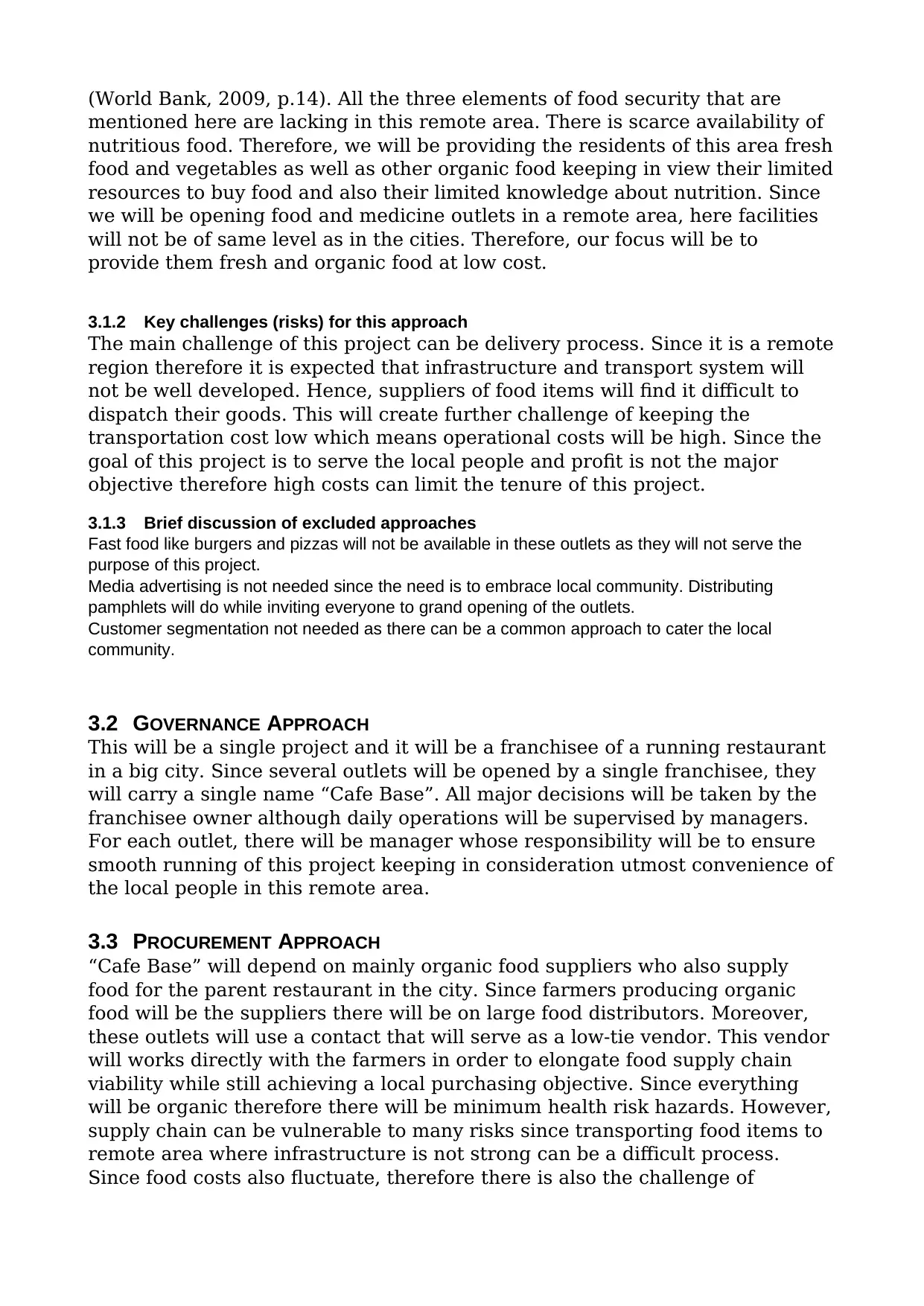
(World Bank, 2009, p.14). All the three elements of food security that are
mentioned here are lacking in this remote area. There is scarce availability of
nutritious food. Therefore, we will be providing the residents of this area fresh
food and vegetables as well as other organic food keeping in view their limited
resources to buy food and also their limited knowledge about nutrition. Since
we will be opening food and medicine outlets in a remote area, here facilities
will not be of same level as in the cities. Therefore, our focus will be to
provide them fresh and organic food at low cost.
3.1.2 Key challenges (risks) for this approach
The main challenge of this project can be delivery process. Since it is a remote
region therefore it is expected that infrastructure and transport system will
not be well developed. Hence, suppliers of food items will find it difficult to
dispatch their goods. This will create further challenge of keeping the
transportation cost low which means operational costs will be high. Since the
goal of this project is to serve the local people and profit is not the major
objective therefore high costs can limit the tenure of this project.
3.1.3 Brief discussion of excluded approaches
Fast food like burgers and pizzas will not be available in these outlets as they will not serve the
purpose of this project.
Media advertising is not needed since the need is to embrace local community. Distributing
pamphlets will do while inviting everyone to grand opening of the outlets.
Customer segmentation not needed as there can be a common approach to cater the local
community.
3.2 GOVERNANCE APPROACH
This will be a single project and it will be a franchisee of a running restaurant
in a big city. Since several outlets will be opened by a single franchisee, they
will carry a single name “Cafe Base”. All major decisions will be taken by the
franchisee owner although daily operations will be supervised by managers.
For each outlet, there will be manager whose responsibility will be to ensure
smooth running of this project keeping in consideration utmost convenience of
the local people in this remote area.
3.3 PROCUREMENT APPROACH
“Cafe Base” will depend on mainly organic food suppliers who also supply
food for the parent restaurant in the city. Since farmers producing organic
food will be the suppliers there will be on large food distributors. Moreover,
these outlets will use a contact that will serve as a low-tie vendor. This vendor
will works directly with the farmers in order to elongate food supply chain
viability while still achieving a local purchasing objective. Since everything
will be organic therefore there will be minimum health risk hazards. However,
supply chain can be vulnerable to many risks since transporting food items to
remote area where infrastructure is not strong can be a difficult process.
Since food costs also fluctuate, therefore there is also the challenge of
mentioned here are lacking in this remote area. There is scarce availability of
nutritious food. Therefore, we will be providing the residents of this area fresh
food and vegetables as well as other organic food keeping in view their limited
resources to buy food and also their limited knowledge about nutrition. Since
we will be opening food and medicine outlets in a remote area, here facilities
will not be of same level as in the cities. Therefore, our focus will be to
provide them fresh and organic food at low cost.
3.1.2 Key challenges (risks) for this approach
The main challenge of this project can be delivery process. Since it is a remote
region therefore it is expected that infrastructure and transport system will
not be well developed. Hence, suppliers of food items will find it difficult to
dispatch their goods. This will create further challenge of keeping the
transportation cost low which means operational costs will be high. Since the
goal of this project is to serve the local people and profit is not the major
objective therefore high costs can limit the tenure of this project.
3.1.3 Brief discussion of excluded approaches
Fast food like burgers and pizzas will not be available in these outlets as they will not serve the
purpose of this project.
Media advertising is not needed since the need is to embrace local community. Distributing
pamphlets will do while inviting everyone to grand opening of the outlets.
Customer segmentation not needed as there can be a common approach to cater the local
community.
3.2 GOVERNANCE APPROACH
This will be a single project and it will be a franchisee of a running restaurant
in a big city. Since several outlets will be opened by a single franchisee, they
will carry a single name “Cafe Base”. All major decisions will be taken by the
franchisee owner although daily operations will be supervised by managers.
For each outlet, there will be manager whose responsibility will be to ensure
smooth running of this project keeping in consideration utmost convenience of
the local people in this remote area.
3.3 PROCUREMENT APPROACH
“Cafe Base” will depend on mainly organic food suppliers who also supply
food for the parent restaurant in the city. Since farmers producing organic
food will be the suppliers there will be on large food distributors. Moreover,
these outlets will use a contact that will serve as a low-tie vendor. This vendor
will works directly with the farmers in order to elongate food supply chain
viability while still achieving a local purchasing objective. Since everything
will be organic therefore there will be minimum health risk hazards. However,
supply chain can be vulnerable to many risks since transporting food items to
remote area where infrastructure is not strong can be a difficult process.
Since food costs also fluctuate, therefore there is also the challenge of
Paraphrase This Document
Need a fresh take? Get an instant paraphrase of this document with our AI Paraphraser
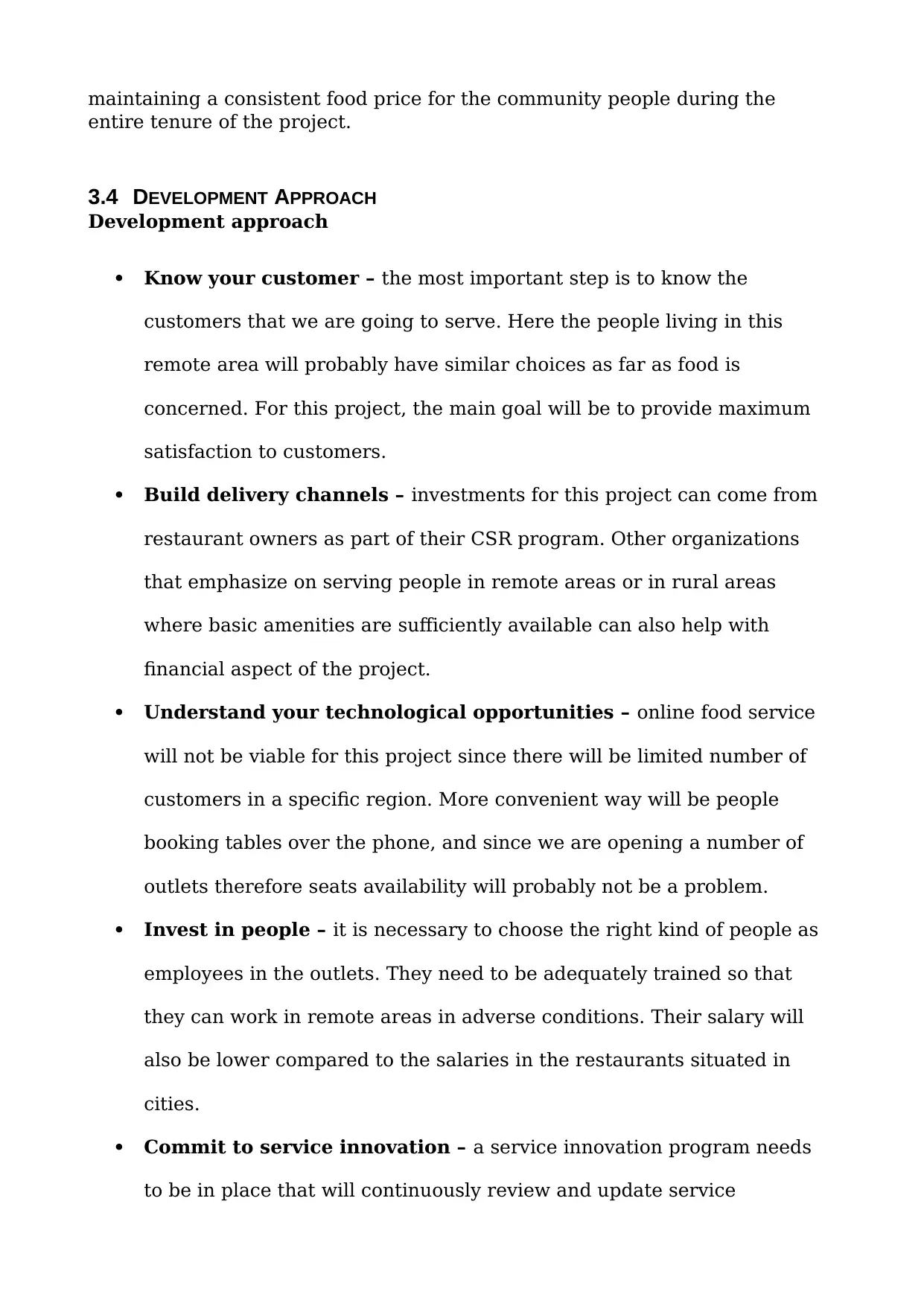
maintaining a consistent food price for the community people during the
entire tenure of the project.
3.4 DEVELOPMENT APPROACH
Development approach
Know your customer – the most important step is to know the
customers that we are going to serve. Here the people living in this
remote area will probably have similar choices as far as food is
concerned. For this project, the main goal will be to provide maximum
satisfaction to customers.
Build delivery channels – investments for this project can come from
restaurant owners as part of their CSR program. Other organizations
that emphasize on serving people in remote areas or in rural areas
where basic amenities are sufficiently available can also help with
financial aspect of the project.
Understand your technological opportunities – online food service
will not be viable for this project since there will be limited number of
customers in a specific region. More convenient way will be people
booking tables over the phone, and since we are opening a number of
outlets therefore seats availability will probably not be a problem.
Invest in people – it is necessary to choose the right kind of people as
employees in the outlets. They need to be adequately trained so that
they can work in remote areas in adverse conditions. Their salary will
also be lower compared to the salaries in the restaurants situated in
cities.
Commit to service innovation – a service innovation program needs
to be in place that will continuously review and update service
entire tenure of the project.
3.4 DEVELOPMENT APPROACH
Development approach
Know your customer – the most important step is to know the
customers that we are going to serve. Here the people living in this
remote area will probably have similar choices as far as food is
concerned. For this project, the main goal will be to provide maximum
satisfaction to customers.
Build delivery channels – investments for this project can come from
restaurant owners as part of their CSR program. Other organizations
that emphasize on serving people in remote areas or in rural areas
where basic amenities are sufficiently available can also help with
financial aspect of the project.
Understand your technological opportunities – online food service
will not be viable for this project since there will be limited number of
customers in a specific region. More convenient way will be people
booking tables over the phone, and since we are opening a number of
outlets therefore seats availability will probably not be a problem.
Invest in people – it is necessary to choose the right kind of people as
employees in the outlets. They need to be adequately trained so that
they can work in remote areas in adverse conditions. Their salary will
also be lower compared to the salaries in the restaurants situated in
cities.
Commit to service innovation – a service innovation program needs
to be in place that will continuously review and update service
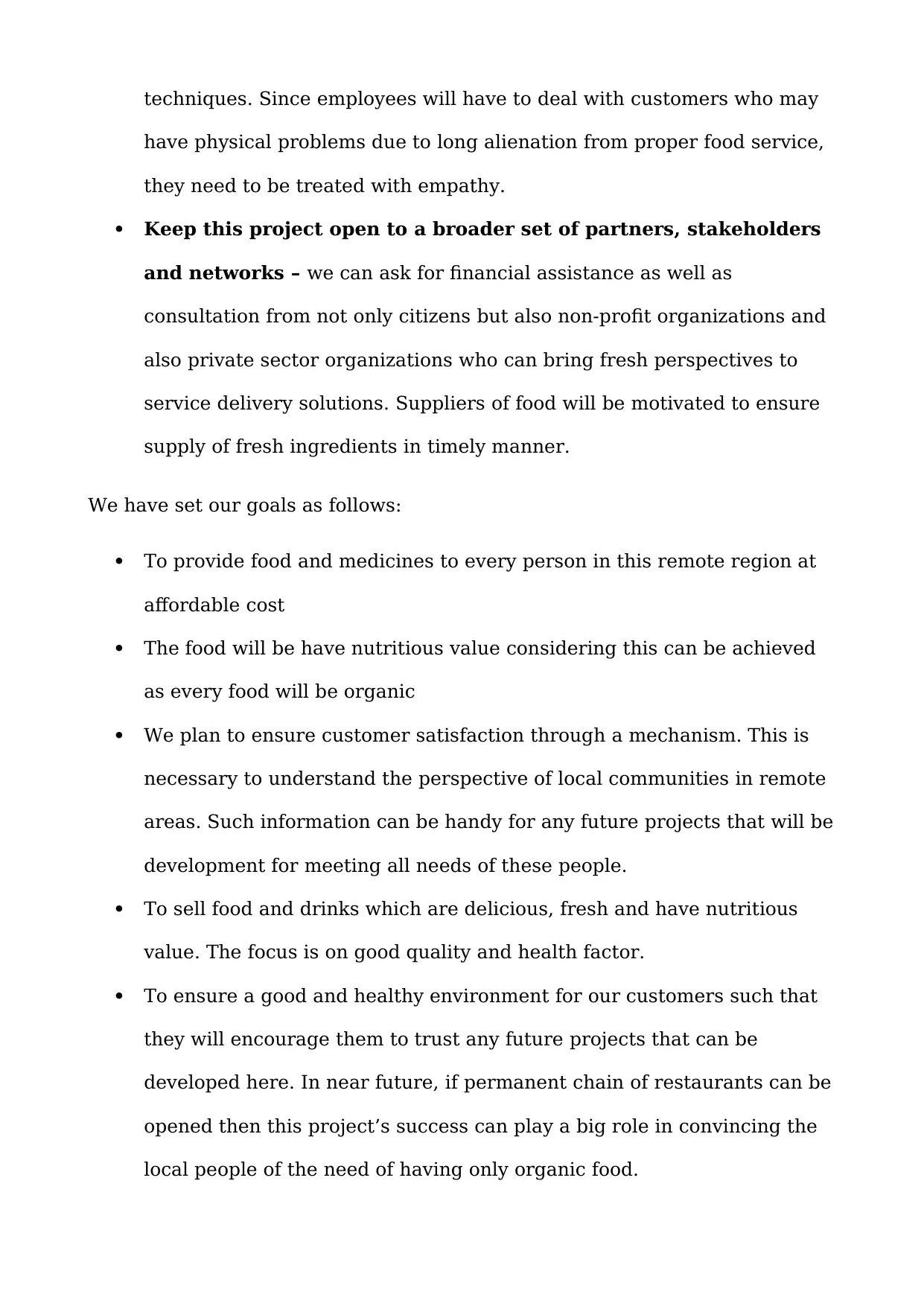
techniques. Since employees will have to deal with customers who may
have physical problems due to long alienation from proper food service,
they need to be treated with empathy.
Keep this project open to a broader set of partners, stakeholders
and networks – we can ask for financial assistance as well as
consultation from not only citizens but also non-profit organizations and
also private sector organizations who can bring fresh perspectives to
service delivery solutions. Suppliers of food will be motivated to ensure
supply of fresh ingredients in timely manner.
We have set our goals as follows:
To provide food and medicines to every person in this remote region at
affordable cost
The food will be have nutritious value considering this can be achieved
as every food will be organic
We plan to ensure customer satisfaction through a mechanism. This is
necessary to understand the perspective of local communities in remote
areas. Such information can be handy for any future projects that will be
development for meeting all needs of these people.
To sell food and drinks which are delicious, fresh and have nutritious
value. The focus is on good quality and health factor.
To ensure a good and healthy environment for our customers such that
they will encourage them to trust any future projects that can be
developed here. In near future, if permanent chain of restaurants can be
opened then this project’s success can play a big role in convincing the
local people of the need of having only organic food.
have physical problems due to long alienation from proper food service,
they need to be treated with empathy.
Keep this project open to a broader set of partners, stakeholders
and networks – we can ask for financial assistance as well as
consultation from not only citizens but also non-profit organizations and
also private sector organizations who can bring fresh perspectives to
service delivery solutions. Suppliers of food will be motivated to ensure
supply of fresh ingredients in timely manner.
We have set our goals as follows:
To provide food and medicines to every person in this remote region at
affordable cost
The food will be have nutritious value considering this can be achieved
as every food will be organic
We plan to ensure customer satisfaction through a mechanism. This is
necessary to understand the perspective of local communities in remote
areas. Such information can be handy for any future projects that will be
development for meeting all needs of these people.
To sell food and drinks which are delicious, fresh and have nutritious
value. The focus is on good quality and health factor.
To ensure a good and healthy environment for our customers such that
they will encourage them to trust any future projects that can be
developed here. In near future, if permanent chain of restaurants can be
opened then this project’s success can play a big role in convincing the
local people of the need of having only organic food.
⊘ This is a preview!⊘
Do you want full access?
Subscribe today to unlock all pages.

Trusted by 1+ million students worldwide
1 out of 16
Related Documents
Your All-in-One AI-Powered Toolkit for Academic Success.
+13062052269
info@desklib.com
Available 24*7 on WhatsApp / Email
![[object Object]](/_next/static/media/star-bottom.7253800d.svg)
Unlock your academic potential
Copyright © 2020–2025 A2Z Services. All Rights Reserved. Developed and managed by ZUCOL.





